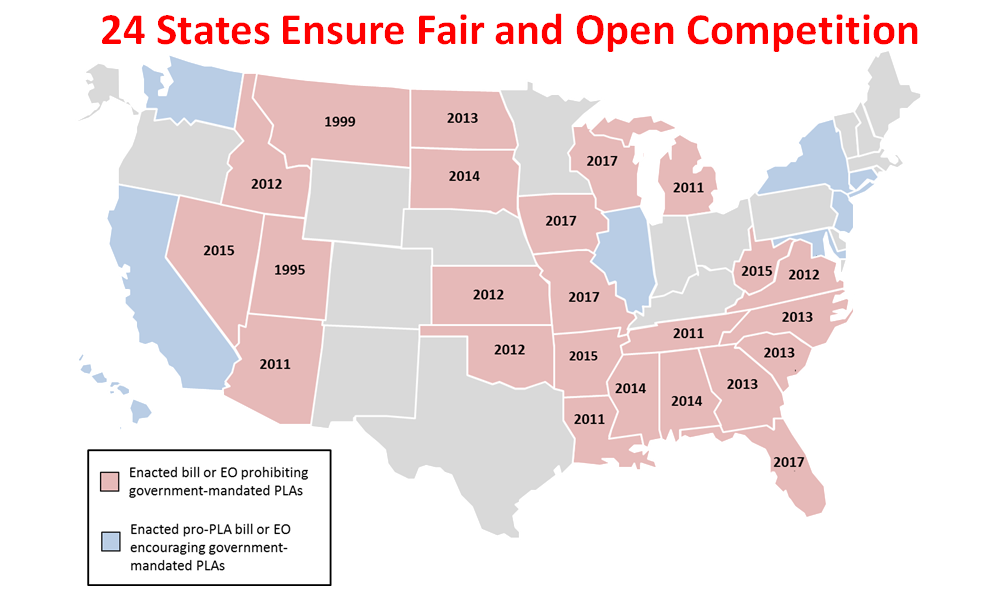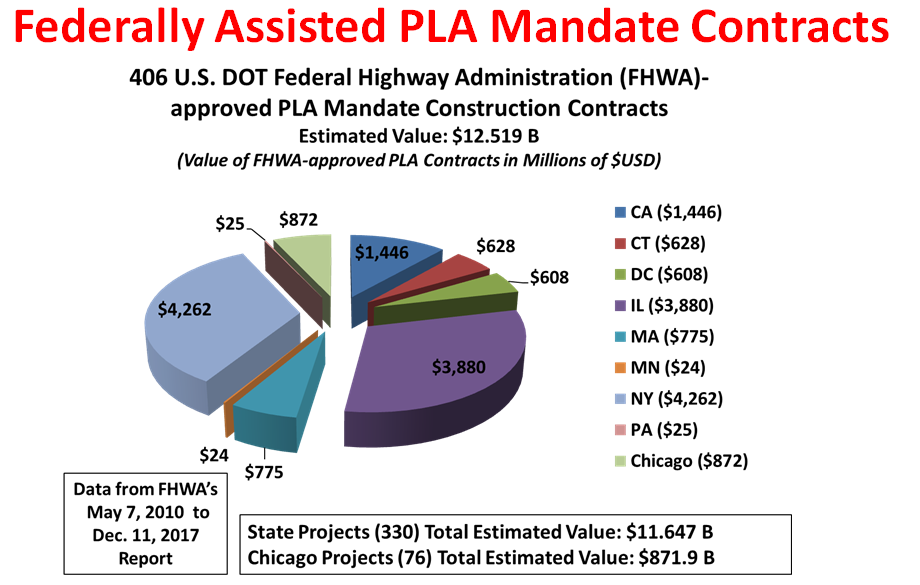A Total of 24 States Restrict Government-Mandated Project Labor Agreements
On Feb. 6, 2009, President Obama signed Executive Order 13502, which encourages federal agencies to mandate controversial project labor agreements (PLAs) on large-scale federal construction projects—those exceeding $25 million in total value—on a case-by-case basis, and permits states and localities to mandate PLAs on federally assisted projects.
Since President Obama issued Executive Order 13502, 23 states have rejected this policy and adopted legislation or executive orders ensuring fair and open competition on state and local public works projects, bringing the total number of states to enact such measures to 24.
Simply put, these 24 states have adopted measures to create the conditions for the vast majority of skilled local labor and qualified contractors to compete to deliver to taxpayers the best possible product at the best possible price.

An inclusive policy that creates the best value for taxpayers and ensures that all Americans have a fair shot at improving their local communities and rebuilding U.S. infrastructure is a win-win for taxpayers and the economy.
In 2017, Iowa, Wisconsin, Missouri and Florida passed new measures or strengthened existing laws requiring fair and open competition on public construction projects. In 2015, Nevada, West Virginia and Arkansas passed similar legislation, while Maine’s 2011 statute sunset in October 2015. In 2018, a number of state legislatures are expected to examine similar legislative proposals.
Fortunately, all legal challenges to state and federal policies ensuring government neutrality in contracting have failed.

Fair and open competition reforms in almost half of all states ensured that at least $258.53 billion of state and local government construction projects from 2007 through 2015 were free from government-mandated PLAs. In addition, an estimated $83.23 billion worth of taxpayer-funded state and local construction projects in 24 states will be subject these pro-taxpayer policies in 2018.
However, some states with Democratic governors or Democrat-controlled legislatures have enacted policies promoting government-mandated PLAs on state and state-assisted projects at the expense of taxpayers and the economy even though just 14 percent of the U.S. construction industry belongs to a union.
PLAs typically ensure construction contracts are awarded only to companies that agree to recognize unions as the representatives of their employees on that job; use the union hiring hall to obtain workers at the expense of existing qualified employees; obtain apprentices exclusively through union apprenticeship programs; follow inefficient union work rules; pay into union benefit and multi-employer pension plans workers will never benefit from, unless they meet vesting requirements; and force workers to pay union dues and/or join a union as a condition of employment.
When mandated by a government agency on taxpayer-funded projects, PLAs drive up the cost of construction projects anywhere from 12 percent to 18 percent, on average, according to a series of academic studies. For example, a study published in May 2017 found Ohio school projects subject to government-mandated PLAs were 13 percent more expensive compared to school projects not built with PLA mandates.
In addition, federal agencies have permitted, and in some cases encouraged, state and local governments to require PLAs on billions of dollars’ worth of state and local projects receiving federal money and other forms of federal assistance.
It is unclear how many federally assisted contracts have suffered from state and local government-mandated PLAs, but snapshots of data demonstrate it is significant. For example, according to a U.S. Department of Transportation (DOT) Federal Highway Administration (FHWA) report of projects receiving FHWA funds from May 7, 2010, to December 11, 2017, state and local lawmakers mandated PLAs on 406 projects totaling an estimated $12.519 billion. (Note: FHWA’s previous report, issued 2/13/17, can be found here).

The Trump administration should follow the lead of 24 states and create the conditions to make America’s infrastructure great again by rescinding President Obama’s failed policy and replacing it with a win-win solution that protects taxpayers, spurs economic growth and allows all Americans to rebuild U.S. infrastructure.












One Response to A Total of 24 States Restrict Government-Mandated Project Labor Agreements
[…] contrast, a total of 24 states have enacted policies encouraging fair and open competition and the federal government should follow this example. It would be a win-win for taxpayers and the […]